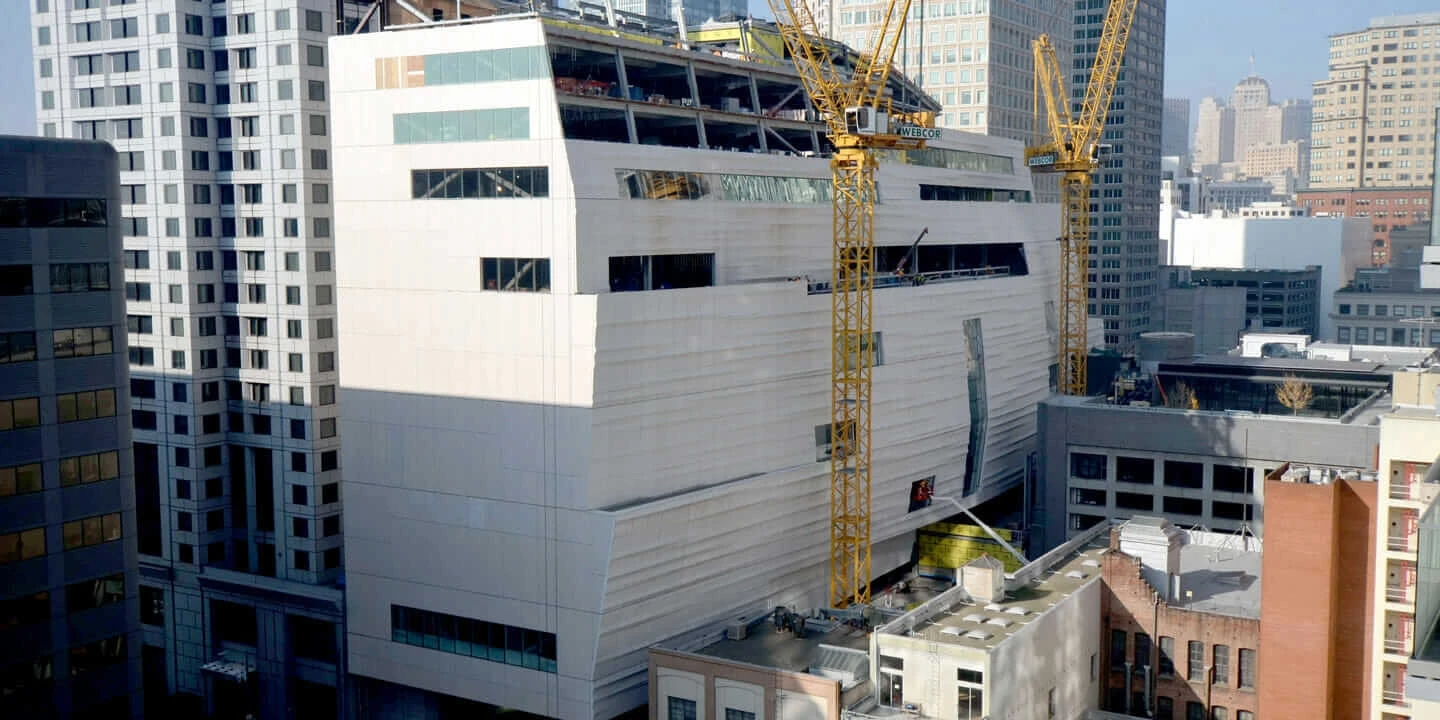& Construction

Integrated BIM tools, including Revit, AutoCAD, and Civil 3D
& Manufacturing

Professional CAD/CAM tools built on Inventor and AutoCAD
Can you fathom a time when buildings are no longer constructed with steel and concrete? No more cement foundations and no more supertall buildings erected with I-beams?
William Kreysler, president of Kreysler & Associates (K&A)—a custom fabrication firm working on architecture, art, and industrial projects—believes a more innovative and efficient era of building is coming. But he admits that it won’t happen overnight, due in large part to the Industrial Revolution (and the 19th century’s abundance of materials and cheap energy).
With 40% of energy now consumed by buildings, Kreysler says it’s time the construction industry made some serious changes now that materials and energy are diminishing, and abundant waste causes more ecological damage. Essentially, it’s time to think about buildings of the future.
Before Kreysler started his firm 25 years ago, he built racing sailboats. The boating industry is where he began fabricating with strong, malleable, durable, and less wasteful materials using monocoque systems, an approach to building where the external skin of an object takes on the weight load and provides support of the structure. Monocoque structures emulate the way nature designs—for example, weaver-bird nests and termite castles—which is a more efficient use of materials and energy.
Kreysler also cites automotive and aircraft industries for using leading-edge monocoque systems. “It used to be you’d see these Indy cars hit the wall, and people would never survive,” Kreysler says. “Nowadays, these carbon-fiber monocoque bodies are so tough and durable, they can hit the wall and the thing spins around, bounces, and the guy unbuckles himself.”
Taking what he learned from the boating industry, Kreysler parlayed fiberglass and monocoque systems into fabrication for buildings. But it wasn’t an easy sell at first.
“When we first started trying to introduce composites and fiberglass to the construction industry,” Kreysler says, “one thing they were concerned about was, how long will it last? It didn’t seem to do any good to show them thousands of fiberglass boats in the marina that have been there for 50 or 60 years.”
To prove their case, Kreysler’s team had to do some testing. “One of the things that we learned was if we put this inorganic filler in with the color coding and sandblasted it to expose the sand,” he says, “it oxidized a little more slowly, it was very durable and easy to repair, it didn’t change color over a long period of time, and it looked a little bit like stone, which made everybody a little more comfortable.”
So they used it as a surface coat over molded fiber-reinforced polymer (FRP) composite structures. But although they were able to prove the strength of the materials they were using, contractors were still concerned about building codes. Fiberglass has resin in it, and resin burns. Fortunately, the sand filler tempered the burn factor, and the composite material got the green light.
And FRP can compete with the strength of I-beams. When you mix fiber (such as carbon fiber, glass fiber, or Kevlar) with cement or resin (for example, polyester resin or epoxy resin), you can build something “mind-blowingly strong,” Kreysler says.
“Shape has a lot to do with strength,” he says. “The same thing that isn’t strong enough to withstand the wind load as a flat surface, if you bend it into a curve, now it might have no problem with the wind load. So as shapes start to become a part of the architectural design, the potential for using the shape structurally begins to occur, and that’s where monocoque systems make sense.”
One example is a monocoque shell he and his team built for a home in Tiburon, CA. The structure had to be strong, not because of its size but rather to handle the wind factor. “The building codes will say, ‘If you’re going to build a house, it has to be strong enough to withstand a certain amount of wind at 100 mph in this particular location.’”
Meanwhile, the Bing Concert Hall in Stanford, CA. is what Kreysler calls a “quasi-monocoque” project. His team installed fiberglass acoustic panels on the walls and ceiling that were reinforced more than necessary. “Monocoque systems are often brought in late in the game and aren’t as efficient as they could be,” he says. “The [panels] were attached to elaborate steel support systems based on the assumption that they were going to be made by a different material. Had the engineers been talking to us all along, it probably would’ve changed the way they did the structure.”
The lack of collaboration across stakeholders (architects, contractors, engineers, and fabricators) contributed to the waste of time, energy, and materials, as did the engineers’ hesitations about using the composite materials.
“The engineers get nervous because they don’t understand these materials very well,” Kreysler says. “They have to put their stamp on the drawings that guarantees that this thing is going to be strong enough. Too often, their way of doing that is by over-designing things. The engineer is over-designing it, the architect may be over-designing it, the fabricator is over-designing it, and the guy who makes the steel I-beam is saying it’s good for 10,000 pounds when really, it’s probably good for 15,000 pounds, but he’s not going to take a chance and say 15. So everybody piles on all these safety factors, and pretty soon you’ve got a building that’s 100 times stronger than it needs to be.”
However, K&A’s collaboration with the San Francisco Museum of Modern Art (SF MoMA) is a case where cross-team collaboration made a huge difference. Webcor, the general contractor on the project, and Enclos, the subcontractor that did the entire building envelope, trusted K&A to coordinate directly with the architects to create the rippled fiberglass façade.
“They knew there was going to be a massive amount of coordination to get all these details figured out,” he says. “And frankly, they were smart enough to realize that it wasn’t going to do any good to have them in the middle of it all. We bring knowledge about our systems that the architect doesn’t happen to know.”
That collaboration saved an incredible amount of money and materials. “The façade is fiberglass, and because it’s extremely lightweight and strong, that made it possible for engineers to take one million pounds of steel away and eliminate a whole entire backup support system they were expecting to use,” Kreysler says.
So will there come a day when building projects will no longer require steel and concrete? Kreysler seems to think so. “Yeah, but I think it’s a ways off,” he says. “But I honestly believe it will when a few things happen that illustrate that it’s possible to get rid of a lot of that kind of stuff. When buildings are no longer heavy and are strong enough to support themselves, then the need for that foundation is going to start becoming less and less important.”
Kreysler recalls the relocation of Boeing Corporate Headquarters as one example. The company moved from Seattle to Chicago 25 years ago and built a skyscraper over an active set of train tracks. Instead of traditional structural supports and foundation, the engineers created trusses to cantilever the building over the tracks.
And in the future, it’s possible that high-rises constructed from carbon-fiber filaments and 3D-printed buildings (when those materials are strong enough) could disrupt the steel industry. “The day will come when machines will be making buildings like weaver birds weave nests and like spiders weave webs,” Kreysler says. But even when the technology is ready, the construction industry will likely drag its heels.
“It’s just that it’s so radical that nobody’s got the courage to do it,” Kreysler says. “If you had $200 million dollars, and you wanted to invest it in a high-rise, would you go, ‘Hey, let’s give it a try?’ I mean, how do you convince people to take a chance? So you do it incrementally, like this woman in Tiburon who let us fabricate her house, and like [design firm] Snøhetta who let us take some of these ideas and apply them to the SF MoMA building façade. So it’s not going to happen overnight, but little by little, it’s ultimately shifting.”
Kylee Swenson is a writer, musician, admirer of great design, and director of content development and owned media at Autodesk.
Emerging Tech
AECO
AECO









